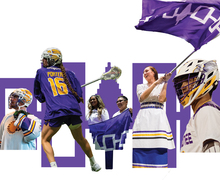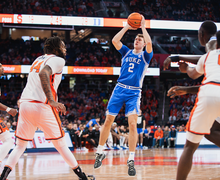Student aims to end racial divide at SU
As a child, Ronald Taylor was a sharp dresser. Not because he wanted to, but because he had to.
“Growing up, my mom said that I had to dress over,” he said, dressed in a gray blazer with faint blue lines and matching pants. An Oxford shirt peeks from underneath his jacket, and a black scarf is tucked firmly around his neck. He peers through a set of thick-rimmed glasses.
Even on regular school days, Taylor wouldn’t be caught in jeans and a T-shirt. He’d sport khakis, a button-up and tie.
“You have to hold yourself at an even higher pedestal because people think lesser of you because you’re black and male,” Taylor’s mom told him.
Taylor, a sophomore political science and public policy major, has taken the lessons he has learned about perception and racial stigmas and applied them to his experience at Syracuse University. He recently coordinated the “Healing the Scars” event, a panel discussion on diversity and race issues among students. A sit-in is expected to follow after Spring Break.
Campus self-segregation has tugged at Taylor’s mind since he first set foot on campus in 2011. Since his freshman year, he has witnessed little interaction between students across races and few forums for students to pose diversity-related issues at SU.
“Healing the Scars,” the Feb. 26 event aimed at addressing issues of inclusion and self-segregation, had been in the works since January. What started as a small discussion about diversity-related issues on campus evolved into an event that filled the lower level of Hendricks Chapel. The decision to host a larger event stemmed from racially charged backlash from a fight that spilled into the streets following a dance party in the Schine Student Center.
Eight students were arrested outside of Schine on Feb. 3 in relation to the dance party “Faded,” an event sponsored by the National Association of Latino Fraternal Organizations and the National Pan-Hellenic Council. Another student was arrested outside of the John C. Dillon Public Safety Building. The fight brought the significance of the diversity discussion to the forefront for Taylor.
Some online commenters on The Post-Standard and The Daily Orange’s websites blamed an increased number of minority students at SU for the violence and school’s lower national rankings. This helped spur Taylor’s efforts.
Taylor said he hates playing the race card and doesn’t “want to beat a dead horse.” He’s wary some might cast the “Healing the Scars” event and its subsequent conversations as dealing with a “black or Hispanic issue.” But the scope of this conversation exceeds that, he said.
“Nothing is ever a race issue because if someone feels the need to make a comment be known and they feel it’s because of their race, it’s because of a behavior or a function of society that they’ve seen happen.”
With help from Hendricks and the Office of Multicultural Affairs, planning for “Healing the Scars” took off. About 250 students filled the lower level of Hendricks during the event, their voices ringing against chapel walls.
“I don’t live in my past. I live in my present. I’m equal to everyone because of the simple fact that I know who fought for my chance to be here right now,” one student said at the event.
Students cycled one after another, speaking into one of two microphones, airing thoughts on campus self-segregation, minority tokenization and racial stigmas.
Hendricks Dean Tiffany Steinwert, who worked closely with Taylor in coordinating the event, likened Taylor’s insistence on addressing pressing issues to a passage in the Hebrew Testamentabout a “voice crying out in the wilderness.”
“Ronald embodies that. Someone who continues to call out and say there’s more work to be done, and we can do that together,” Steinwert said.
For Taylor, who maintained a fixed, thoughtful expression through most of the night’s events, the panel was a culmination of personal observations and experiences, on campus and beyond.
Taylor was taught from a young age that stigmas about black men exist. To combat this, his mother urged him to “out-educate” his peers.
“Always stay a step ahead, always have that extra drive just because people will think less of you. I always had that internal dialogue — why do people think less?” he said. “It’s because of the society we live in. America in general is so polarized on race and polarized on stereotypes that we sort of bar ourselves on having those conversations on race, whatever the case is.”
A similar drive to “out-educate” followed Taylor to SU, where he has set a personal GPA goal of 3.8 for each semester. In classroom settings, Taylor said he has felt the stigma of black males being academically inferior superimposed on him. He has been complimented time and time again on his ability to “speak well,” as if he wasn’t expected to.
“Why is it that if my good white friend John over here speaks really well, he doesn’t get the same compliment?” Taylor said.
Scan Taylor’s resume and it’s clear he stays steps ahead. In addition to being a Coronat Scholar and Renee Crown University Honors student, Taylor belongs to the Black Celestial Choral Ensemble, Black Communications Society, Multicultural Empowerment Network, Redemption A Capella and the Creations Dance Company. Off campus, he has interned for a congresswoman and served on the Youth Advisory Board for the Tavis Smiley Foundation.
Taylor sets his personal expectations high so no one can say he’s unqualified to attend the university.
Despite his obligations, Taylor never missed a deadline in his freshman public affairs class, said his professor, William Coplin. Taylor was chosen to be one of the 18 undergraduate teaching assistants for the class the following semester.
Changing the way people think and their preconceived notions of one another is an ambitious undertaking for a sophomore college student, but Taylor is practiced in rallying a community behind a common cause. Prior to coordinating the “Healing the Scars” panel, he helped establish a mentoring program at Wilson Park Community Center, located in the housing projects neighboring the Brewster/Boland/Brockway Complex.
Of the 150 public affairs students Coplin oversees, Taylor stands out because of his follow-through and relentless desire to do good.
“He’s at the top of the list.”
Published on March 6, 2013 at 12:28 am
Contact Debbie: dbtruong@syr.edu | @debbietruong





